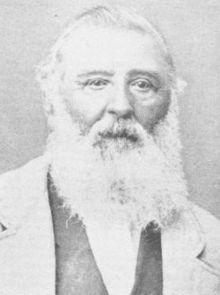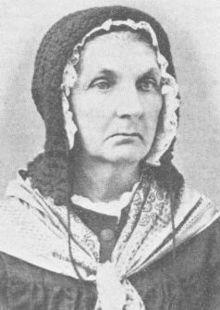Robert Justus Kleberg
Johann Christian Justus Robert Kleberg (born September 10, 1803 in Herstelle near Beverungen , Höxter County , Westphalia , † October 23, 1888 in Cuero near Yorktown , DeWitt County , Texas , USA ) was a soldier in the Texas War of Independence (" Hero of San Jacinto " ) and during the Civil War , Chairman of the Texas Land Commission (1838), Chief Justice of Austin County (1846), Commissioner of DeWitt County (1848), and Chief Justice of DeWitt County (1853-1854).
family
Robert Justus Kleberg was the son of the wealthy businessman Lucas Kleberg (1740–?) And his wife Veronika Meier (1740–?).
Kleberg married on September 4, 1834 in Marienmünster (Höxter district, Westphalia) Rosalia von Roeder (* July 20, 1813 in Vörden (Marienmünster) , Westphalia, † July 3, 1907 in Yorktown), the daughter of Anton Ludwig Sigismund von Roeder ( 1774–1847) and Caroline Luise Sack (1782–1865). The couple had eight children. It was Rosalia von Roeder who persuaded her fiancé to emigrate and only wanted to marry him on this condition. She was an enthusiastic botanist and had close contact with Ferdinand Lindheimer (1801–1879). Kleberg's brother-in-law was Albrecht von Roeder (1811–1857), a fellow student from Göttingen's academic years.
Both a son and a grandson bore his name - Robert J. Kleberg Sr. and Jr. - and became successful in Texas: Robert Sr. (1853–1932) was a lawyer and wealthy owner of the King Ranch , which with its 825,000 acres ( > 330,000 hectares ) cross-border in the counties Nueces , Kenedy , Kleberg and Willacy , Robert Jr. (1896–1974) was heir to the King Ranch and a partner in several holdings . Today a Kleberg hospital, a Kleberg library and other facilities are financed by Kleberg foundations.
Life
Youth in Germany
In his childhood the parents moved with their children from Herstelle to Beverungen. The children received the best education at the grammar school in Holzminden ( Lower Saxony ), but after a few years the father had bad luck financially and died soon after, so that the children were on their own.
Kleberg absolutely wanted to become a lawyer and completed his law studies at the University of Göttingen with a doctorate after only two and a half years . At the university he also met his later brother-in-law Albrecht von Roeder. After a year of service in Nieheim (Höxter district) and a few other positions in practical vocational training, in 1834 he was actually at the beginning of an excellent legal career.
But he was persuaded by his fiancée to emigrate with her extended family - like many others at the time - to North America and to settle in the then "promised land" of Texas. Texas was still largely uninhabited, but people in Germany had heard a lot of good things and, unfortunately, all too romantic about this country, not least through the widespread letter from the emigrant Friedrich Ernst, father of Caroline Ernst , who had been there in Industry in Austin County since 1831 lived. In September 1834, the young trainee lawyer, Kleberg, married Rosalia von Roeder in Marienmünster.
Emigrated to Texas
When the decision to emigrate was finally made, the three oldest Roeder children Ludwig, Albrecht , Joachim and sister Valeska were sent to Texas with the servant Pollhart as the vanguard to prepare for the arrival of the extended family. You should see the letter writer Friedrich Ernst. When the news of the safe arrival of this vanguard finally arrived six months after their departure from Germany, the rest of the family set out on the grueling crossing to Texas on September 30, 1834 on board the Congress under Captain J. Adams. The tour group consisted of Robert J. Kleberg and his wife Rosalia, Ludwig Kleberg, father Ludwig von Roeder with his wife, his daughters Luise and Caroline, his sons Rudolph with his fiancée Antoinette von Donop, Otto with his wife Pauline von Donop and Wilhelm von Roeder. The other passengers were Germans from the Grand Duchy of Oldenburg , including a brother-in-law of the letter writer Friedrich Ernst. They all wanted to settle in Texas together and after 60 days they finally reached New Orleans in the state of Louisiana .
After the first extremely exciting months full of mishaps and mishaps in the USA, the description of which must be dispensed with here, in the winter of spring 1835 most of the group finally reached the place in Austin County, where Catspring was to be founded. From then on Kleberg acted as spokesman for this group. While the women stayed in Harrisburg , the men built the first houses. As academics and intellectuals, so-called “ Latins ”, they were not at all skilled in their craft, which is why this house construction took a long time. During this time she lived peacefully alongside Kikapoo - Indians who helped them even occasionally. At the beginning of September 1835 two log houses were finally completed so that the rest of the family could be fetched from Harrisburg.
Living in Austin County
Soon after, Kleberg fought as a soldier in the Texan War of Independence in 1835 and 1836, including in the battles of Alamo (March 6, 1836), later San Antonio in Bexar County , and San Jacinto (April 21, 1836), and served afterwards of the Revolution in the Texas Army for six months. As a thank you, after Texas became a state of the USA, on October 23, 1845, he received 4,428 acres (approx. 1,800 hectares) of land in Dallas County , on which Kleberg emerged from around 1850 and was incorporated into Dallas in 1978 , and was appointed Associate Commissioner on the Texas Board of Land Commissioners by President Sam Houston in 1837 and chaired that body in 1838. In 1841 he became Justice of the Peace , and in 1846 Chief Justice of Austin County.
Allegedly Kleberg is said to have saved the life of the German botanist Ferdinand Lindheimer when he found this nearby catspring wounded in the Brazos River .
Kleberg and Ludwig von Roeder even had a piano brought to Catspring from Germany and were therefore owners of the first piano in Texas.
Living in DeWitt County
In 1847 the large Kleberg family moved with the von Roeder family to Meyersville in DeWitt County, which was still barely populated - only a few settlers, no schools or churches. Judge Kleberg, together with his brother-in-law Albrecht von Roeder, John York and a few others, built the new school building with their own hands. In October 1848 he fought at the Escondido Creek under the command of Captain John York against consuming and murderous Mexican Lipan Indians that of Coahuila in Mexico were sunken.
In the same year 1848 Kleberg was commissioner and in 1853 chief justice of the county; in the following year 1854 he was re-elected.
After the death of his brother-in-law Albrecht von Roeder, Kleberg looked after his own 7 children as well as the Roeder children. Kleberg was a staunch Democratic supporter and supported the Confederate cause . When the American Civil War broke out in 1861, he even fought with his own unit, but was allegedly not accepted into the official army because of his age (58 years).
Until his death, Kleberg was a proud member of the Texas Veterans Association. His tombstone near his daughter's farm, where he died in 1888, is shaped like a soldiers' tent and bears the inscription " Remember the Alamo ". In 1936 a memorial was erected there.
Honors
- The Kleberg County bears his honor since 1913 his name.
- The city of Kleberg , today a district of Dallas , is named after him.
- Monument at Cuero, DeWitt County
literature
- Gilbert Giddings Benjamin: The Germans in Texas, a Study in Immigration ; based on the notes and memories of Robert Kleberg from 1876; Philadelphia 1910. - Reprint: German American Annals, Volume VII
Web links
- Biography Robert J. Kleberg in the Handbook of Texas (English)
- Biography of Rosalia von Roeder in the Handbook of Texas (English)
- Biography with detailed report about arrival in USA and first months (English)
- History of the city Kleberg (English)
| personal data | |
|---|---|
| SURNAME | Kleberg, Robert Justus |
| ALTERNATIVE NAMES | Kleberg, Johann Christian Justus Robert (full name) |
| BRIEF DESCRIPTION | German-American farmer, soldier and judge |
| DATE OF BIRTH | September 10, 1803 |
| PLACE OF BIRTH | Manufacture , Westphalia |
| DATE OF DEATH | October 23, 1888 |
| Place of death | Cuero , Texas |

